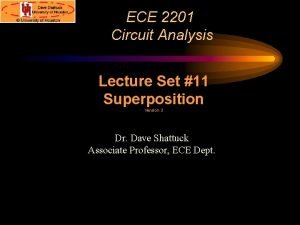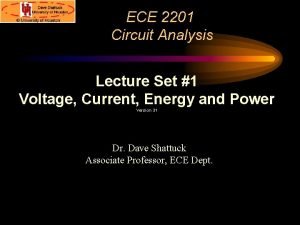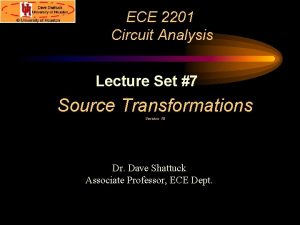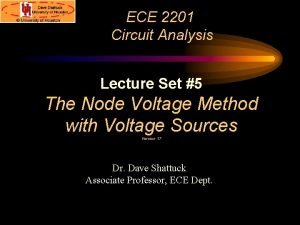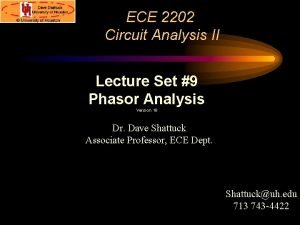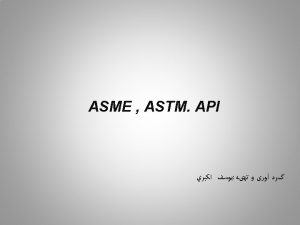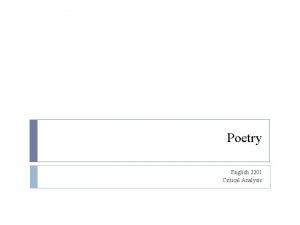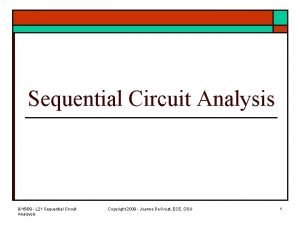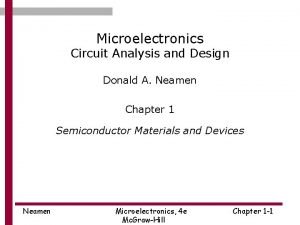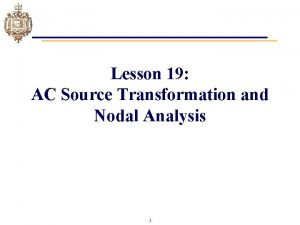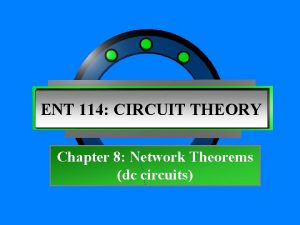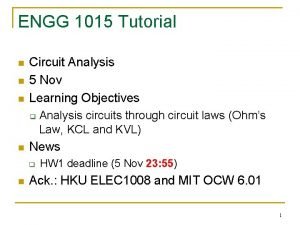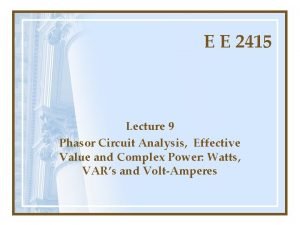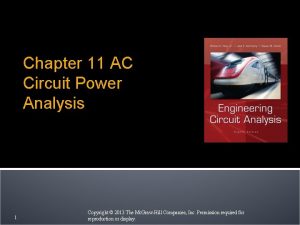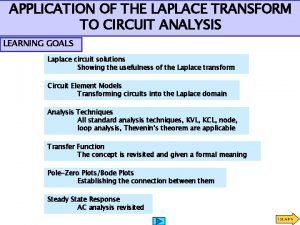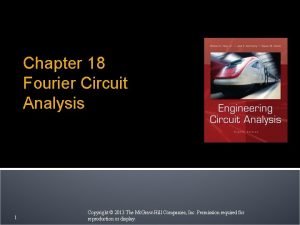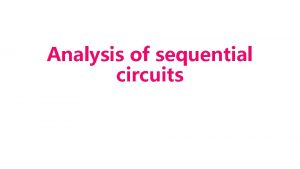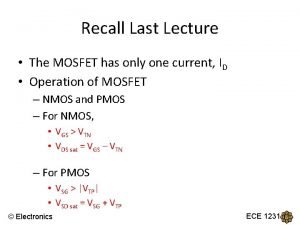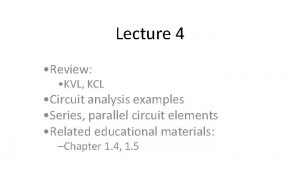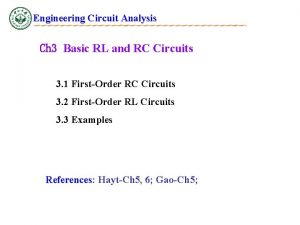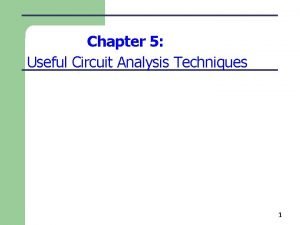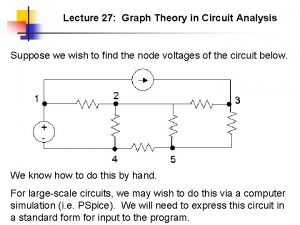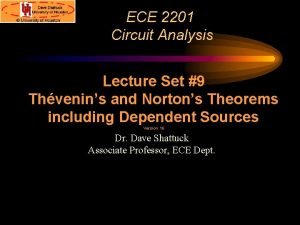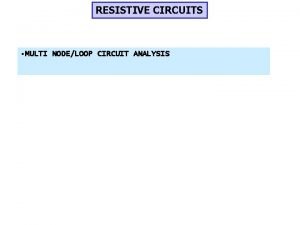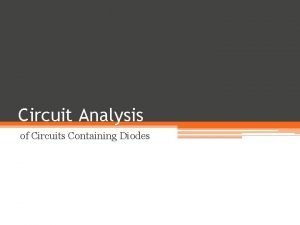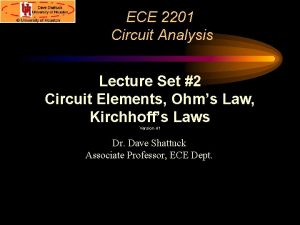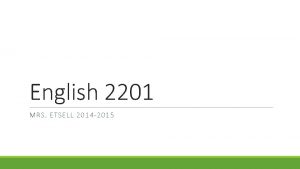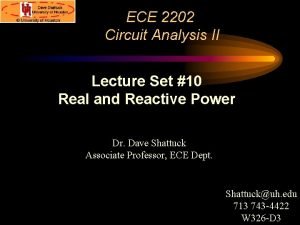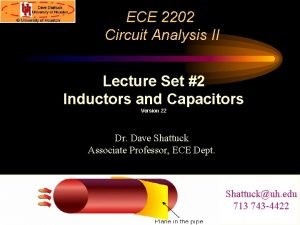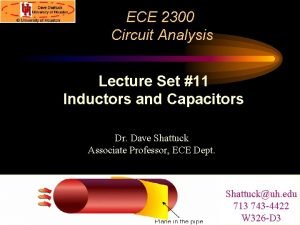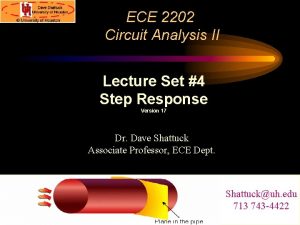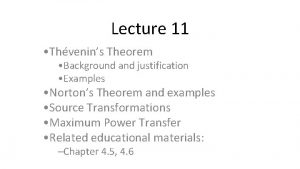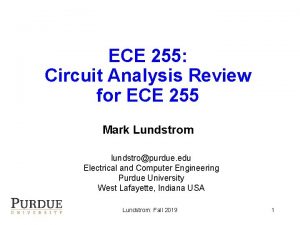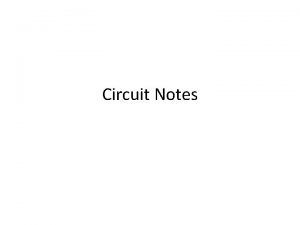ECE 2201 Circuit Analysis Lecture Set 9 Thvenins







































































![Sample Problem #2 a) Find the Norton equivalent as seen by the 22[k. W] Sample Problem #2 a) Find the Norton equivalent as seen by the 22[k. W]](https://slidetodoc.com/presentation_image_h/c724fc3c998fd1617d0ad5f88a5f06da/image-72.jpg)

- Slides: 73

ECE 2201 Circuit Analysis Lecture Set #9 Thévenin’s and Norton’s Theorems including Dependent Sources Version 16 Dr. Dave Shattuck Associate Professor, ECE Dept.

Norton’s Theorem

Overview Norton’s Theorem In this part, we will cover the following topics: • Norton’s Theorem • Finding Norton’s equivalents • Example of finding a Norton’s equivalent

Textbook Coverage This material is introduced in different ways in different textbooks. Approximately this same material is covered in your textbook in the following sections: • Electric Circuits 10 th Ed. by Nilsson and Riedel: Sections 4. 10 and 4. 11

Norton’s Theorem Defined Norton’s Theorem is another equivalent circuit. Norton’s Theorem can be stated as follows: Any circuit made up of resistors and sources, viewed from two terminals of that circuit, is equivalent to a current source in parallel with a resistance. The current source is equal to the short-circuit current for the two-terminal circuit, and the resistance is equal to the equivalent resistance of the circuit.

Note 1 It is probably obvious to you, if you studied the last two parts of this module, that if Thévenin’s Theorem is valid, then Norton’s Theorem is valid, because Norton’s Theorem is simply a source transformation of Thévenin’s Theorem. Note that the resistance value is the same in both cases, that is, RTH = RN = REQ.

Note 2 Any circuit made up of resistors and sources, viewed from two terminals of that circuit, is equivalent to a current source in parallel with a resistance. The current source is equal to the short-circuit current for the twoterminal circuit, and the resistance is equal to the equivalent resistance of the circuit. The polarity of the current source with respect to the terminals is important. If the reference polarity for the short-circuit current is as given here (flowing from A to B), then the reference polarity for the current source must be as given here (current from B to A).

Note 3 Any circuit made up of resistors and sources, viewed from two terminals of that circuit, is equivalent to a current source in parallel with a resistance. The current source is equal to the short-circuit current for the twoterminal circuit, and the resistance is equal to the equivalent resistance of the circuit. As with all equivalent circuits, these two are equivalent only with respect to the things connected to the equivalent circuits.

Note 4 Any circuit made up of resistors and sources, viewed from two terminals of that circuit, is equivalent to a current source in parallel with a resistance. The current source is equal to the short-circuit current for the twoterminal circuit, and the resistance is equal to the equivalent resistance of the circuit. When we have dependent sources in the circuit shown here, it will make some calculations more difficult, but does not change the validity of theorem.

Short-Circuit Current and Open-Circuit Voltage The open-circuit voltage that results from the Norton equivalent is equal to the product of the Norton current source and the Norton resistance. This leads to the same equation that we used previously, for the Thévenin equivalent, When we look at the circuit on the right, we can see that the open-circuit voltage is equal to i. NRN, which is also i. SCREQ. Thus, we obtain the important expression for v. OC, shown here.

Extra note We have shown that for the Norton equivalent, the open-circuit voltage is equal to the short-circuit current times the equivalent resistance. This is fundamental and important. However, it is not Ohm’s Law. This equation is not really Ohm’s Law. It looks like Ohm’s Law, and has the same form. However, it should be noted that Ohm’s Law relates voltage and current for a resistor. This relates the values of voltages, currents and resistances in two different connections to an equivalent circuit. However, if you wish to remember this by relating it to Ohm’s Law, that is fine. Remember that i. SC = i. N, and REQ = RN. Go back to Overview slide.

Finding the Norton Equivalent We have shown that for the Norton equivalent, the open-circuit voltage is equal to the short-circuit current times the equivalent resistance. In general we can find the Norton equivalent of a circuit by finding any two of the following three things: 1) the open circuit voltage, v. OC, 2) the short-circuit current, i. SC, and 3) the equivalent resistance, REQ. Once we find any two, we can find the third by using this equation, Remember that i. SC = i. N, and REQ = RN.

Finding the Norton Equivalent – Note 1 We can find the Norton equivalent of a circuit by finding any two of the following three things: 1) the open circuit voltage, v. OC, 2) the short-circuit current, i. SC = i. N, and 3) the equivalent resistance, REQ = RN. One more time, the reference polarities of our voltages and currents matter. If we pick v. OC at A with respect to B, then we need to pick i. SC going from A to B. If not, we need to change the sign in this equation.

Finding the Norton Equivalent – Note 2 We can find the Norton equivalent of a circuit by finding any two of the following three things: 1) the open circuit voltage, v. OC, 2) the short-circuit current, i. SC = i. N, and 3) the equivalent resistance, REQ = RN. As an example, if we pick v. OC and i. SC with the reference polarities given here, we need to change the sign in the equation as shown. This is a consequence of the sign in Ohm’s Law. For a further explanation, see the next slide.

Finding the Norton Equivalent – Note 3 We can find the Norton equivalent of a circuit by finding any two of the following three things: 1) the open circuit voltage, v. OC, 2) the short-circuit current, i. SC = i. N, and 3) the equivalent resistance, REQ = RN. As an example, if we pick v. OC and i. SC with the reference polarities given here, we need to change the sign in the equation as shown. This is a consequence of Ohm’s Law, which for resistor RN requires a minus sign, since the voltage and current are in the active sign relationship for RN.

Finding the Norton Equivalent – Note 4 We can find the Norton equivalent of a circuit by finding any two of the following three things: 1) the open circuit voltage, v. OC, 2) the short-circuit current, i. SC = i. N, and 3) the equivalent resistance, REQ = RN. Be very careful here! We have labeled the current through RN as i. SC. This is true only for this special case. This i. SC is not the current through the open circuit. The current through an open circuit is always zero. The current i. SC only goes through RN because of the open circuit.

Notes 1. We can find the Norton equivalent of any circuit made up of voltage sources, current sources, and resistors. The sources can be any combination of dependent and independent sources. 2. We can find the values of the Norton equivalent by finding the opencircuit voltage and short-circuit current. The reference polarities of these quantities are important. 3. To find the equivalent resistance, we need to set the independent sources equal to zero. However, the dependent sources will remain. This requires some care. We will discuss finding the equivalent resistance with dependent sources in the fourth part of the module. 4. As with all equivalent circuits, the Norton equivalent is equivalent only with respect to the things connected to it.

Example Problem We wish to find the Norton equivalent of the circuit below, as seen from terminals A and B. Note that there is an unstated assumption here; we assume that we will later connect something to these two terminals. Having found the Norton equivalent, we will be able to solve that circuit more easily by using that equivalent.

Example Problem – Step 1 We wish to find the open-circuit voltage v. OC with the polarity defined in the circuit given below. In general, remember, we need to find two out of three of the quantities v. OC, i. SC, and REQ. In this problem we will find two, and then find the third just as a check. In general, finding the third quantity is not required.

Example Problem – Step 1 (Note) We wish to find the open-circuit voltage v. OC with the polarity defined in the circuit given below. Some students may be tempted to remove resistor R 3 from this circuit. We should not do this. In future problems, if we are asked to find “the equivalent circuit seen by resistor R 3”, then we assume that the resistor “does not see itself”, and remove it. In this problem, we are not given this instruction. Leave the resistor in place, even though the open-circuit voltage is across it.

Example Problem – Step 2 We wish to find the voltage v. OC. Writing KCL at the node encircled with a dashed red line, we have

Example Problem – Step 3 Substituting in values, we have

Example Problem – Step 4 Next, we will find the equivalent resistance, REQ. The first step in this solution is to set the independent sources equal to zero. We then have the circuit below. Note that the voltage source becomes a short circuit, and the current source becomes an open circuit. These represent zerovalued sources.

Example Problem – Step 5 To find the equivalent resistance, REQ, we simply combine resistances in parallel and in series. The resistance between terminals A and B, which we are calling REQ, is found by recognizing that R 5 and R 4 are in series. That series combination is in parallel with R 2. That parallel combination is in parallel with R 3. We have

Example Problem – Step 5 (Note) To find the equivalent resistance, REQ, we simply combine resistances in parallel and in series. The resistance between terminals A and B, which we are calling REQ, is found by recognizing that R 5 and R 4 are in series. That series combination is in parallel with R 2. That parallel combination is in parallel with R 3. We have Some students may have difficulty getting this expression. Remember that we are finding the resistance seen at these two terminals, A and B. The idea is that we would have this resistance if you connected a source to these two terminals.

Example Problem – Step 6 (Solution) To complete this problem, we would typically redraw the circuit, showing the complete Norton’s equivalent, along with terminals A and B. This has been done here. To get this, we need to use our equation to get the Norton current,

Example Problem – Step 7 (Check) Let us check this solution, by finding the short-circuit current in the original circuit, and compare it to the short-circuit current in the Norton’s equivalent. We redraw the original circuit, with the short circuit current shown. We wish to find this short circuit current, i. SC.

Example Problem – Step 8 (Check) We start by noting that there is no current through resistor R 3, since there is no voltage across it. Another way of saying this is that the resistor R 3 is in parallel with a short circuit. The parallel combination of the resistor and the short circuit, will be a short circuit. The same exact argument can be made for the series combination of R 5 and R 4. This series combination is in parallel with a short circuit. Thus, we can simplify this circuit to the circuit on the next slide.

Example Problem – Step 9 (Check) Here, we have removed resistors R 3, R 4 and R 5 since they do not affect the short circuit current, i. SC. When we look at this circuit, we note that the voltage source v. S is directly across the resistor R 2, and so we can write directly,

Example Problem – Step 10 (Check) This short-circuit current is the same result that we found in the Norton’s Equivalent earlier. In retrospect, it is now clear that we did not take the best possible approach to this solution. If we had solved for the short-circuit current, and the equivalent resistance, we would have gotten the solution more quickly and more easily. One of our goals is to be so good at circuit analysis that we can see ahead of time which approach will be the best for a given problem.

What is the deal here? Is this worth all this trouble? • This is a good question. The deal here is that Norton’s Theorem is a very big deal. It is difficult to convey the full power of it at this stage in your education. However, you may be able to imagine that it is very useful to be able to take a very complicated circuit, and replace it with a pretty simple circuit. In many cases, it is very definitely worth all this trouble. • Norton’s Theorem is often treated as being less important than Thévenin’s Theorem. Actually, they are of equal importance, since they say essentially the same thing. One is no more important than the other.

Thévenin’s and Norton’s Equivalents and Dependent Sources

Overview Thévenin’s and Norton’s Equivalents and Dependent Sources In this part, we will cover the following topics: • Dependent Sources and Equivalent Resistance • The Test-Source Method • Example of finding an equivalent resistance with a dependent source present

Textbook Coverage This material is introduced in different ways in different textbooks. Approximately this same material is covered in your textbook in the following sections: • Electric Circuits 10 th Ed. by Nilsson and Riedel: Section 4. 11

Thévenin’s and Norton’s Theorems Reviewed Thévenin’s Theorem and Norton’s Theorem can be stated as follows: Any circuit made up of resistors and sources, viewed from two terminals of that circuit, is equivalent to a voltage source in series with a resistance, or to a current source in parallel with a resistance. The voltage source is equal to the open-circuit voltage for the twoterminal circuit, the current source is equal to the short-circuit current for that circuit, and the resistance is equal to the equivalent resistance of that circuit.

Equivalent Resistance Reviewed When we find the equivalent resistance for a Thévenin’s equivalent or a Norton’s equivalent, we set the independent sources equal to zero, and find the equivalent resistance of what remains. When a dependent source is present, trying to find the equivalent resistance results in a situation we have not dealt with yet. What do we mean by the equivalent resistance of a dependent source? The answer must be stated carefully. If the ratio of voltage to current for something is a constant, then that something can be said to have an equivalent resistance, since it is behaving as a resistance.

Equivalent Resistance of a Source So, what we mean by the equivalent resistance of a dependent source is that in this case the ratio of voltage to current is a constant. Then the source can be said to have an equivalent resistance, since it is behaving as a resistance. The equivalent resistance of a dependent source depends on what voltage or current it depends on, and where that voltage or current is in the circuit. It is not easy to predict the answer.

No Equivalent Resistance for an Independent Source The equivalent resistance of a dependent source, in this case, is the ratio of voltage to current, which is a constant. Then the source can be said to have an equivalent resistance, since it is behaving as a resistance. This will only be meaningful for a dependent source. It is not meaningful to talk about the equivalent resistance of an independent source. The ratio of voltage to current will not be constant for an independent source.

Simple Example with a Dependent Source We will try to explain this by starting with a simple example. We wish to find the equivalent resistance of the circuit below, as seen at terminals A and B. This will mean that the ratio of the voltage across the circuit, labeled v. Q, to the ratio of the current through the circuit, labeled i. Q, must be a constant. Let’s find that constant by finding the ratio.

Simple Example with a Dependent Source – Step 1 We wish to find the equivalent resistance of the circuit below, as seen at terminals A and B. Let’s find the ratio of the voltage across the circuit, labeled v. Q, to the ratio of the current through the circuit, labeled i. Q. This must be a constant. Let’s look first at the circuit equivalent on the right. We note that from Ohm’s Law applied to RX, we can say Next, we apply KCL at the A node to write that

Simple Example with a Dependent Source – Step 2 We wish to find the equivalent resistance of the circuit below, as seen at terminals A and B. On the last slide we found v. Q, and we found i. Q. We take the ratio of them, and plug in the expressions that we found for each. When we do this, we get Note that ratio is a constant. The ratio has units of resistance, which is what we expect when we take a ratio of a voltage to a current.

Simple Example with a Dependent Source – Step 2 (Note) We wish to find the equivalent resistance of the circuit below, as seen at terminals A and B. Let’s find the ratio of the voltage across the circuit, labeled v. Q, to the ratio of the current through the circuit, labeled i. Q. We take the ratio of them, and get The dependent source is in parallel with the resistor RX. Since the parallel combination is 25[W], the dependent source must be behaving as if it were a 33. 33[W] resistor. However, this value depends on RX; in fact, it is RX /3.

2 nd Simple Example with a Dependent Source – Step 1 We wish to find the equivalent resistance of a second circuit, given below, as seen at terminals A and B. Let’s find the ratio of the voltage across the circuit, labeled v. Q, to the ratio of the current through the circuit, labeled i. Q. This must be a constant. We note that from Ohm’s Law applied to RX, we can say that Next, we apply KCL at the A node to write that Note the change in polarity for the source, from the previous example.

2 nd Simple Example with a Dependent Source – Step 2 We wish to find the equivalent resistance of the circuit below, as seen at terminals A and B. On the last slide we found v. Q, and we found i. Q. We take the ratio of them, and plug in the expressions that we found for each. When we do this, we get Note that ratio has changed when we simply changed the polarity of the dependent source. The magnitude is not the only thing that changed; the equivalent resistance is now negative!

Simple Example with a Dependent Source – Step 2 (Note) We wish to find the equivalent resistance of the circuit below, as seen at terminals A and B. Let’s find the ratio of the voltage across the circuit, labeled v. Q, to the ratio of the current through the circuit, labeled i. Q. We take the ratio of them, and get The dependent source is in parallel with the resistor RX. Since the parallel combination is -50[W], the dependent source must be behaving as if it were a -33. 33[W] resistor. This value depends on RX; in fact, it is -RX /3.

Note 1 When we find the equivalent resistance for a Thévenin’s equivalent or a Norton’s equivalent, we set the independent sources equal to zero, and find the equivalent resistance of what remains. We can see that the equivalent resistance can be negative. This is one reason why we have been so careful about polarities all along. We need to get the polarities right to be able to get our signs right.

Note 2 When we find the equivalent resistance for a Thévenin’s equivalent or a Norton’s equivalent, we set the independent sources equal to zero, and find the equivalent resistance of what remains. In the simple examples that we just did, we were effectively applying a source to the terminals of the circuit. This results in a circuit like others that we have solved before, and we can find the ratio of voltage to current. This is usually easier to think about for most students. It is as if we were applying a source just to test the circuit; we call this method the Test. Source Method.

Test-Source Method – Defined To get the equivalent resistance of a circuit, as seen by two terminals of that circuit, we follow these steps. 1) Set all independent sources equal to zero. 2) Find the equivalent resistance. a) If there are no dependent sources, find this equivalent resistance using the equivalent resistance rules that have been used before. These include series combinations, parallel combinations, and delta-to-wye equivalents. b) If there are dependent sources present, apply a test source to the two terminals. It can be either a voltage source or a current source. 1) If you apply a voltage source, find the current through that voltage source. 2) If you apply a current source, find the voltage across that current source. 3) Then, find the ratio of the voltage to the current, which will be the equivalent resistance.

Test-Source Method – Note 1 To get the equivalent resistance of a circuit, as seen by two terminals of that circuit, we follow these steps. 1) Set all independent sources equal to zero. 2) Find the equivalent resistance. a) If there are no dependent sources, findforget this equivalent Don’t this step. resistance It is alwaysusing applied the equivalent resistance rules that have been used before. These whencombinations, finding equivalent resistance. include series combinations, parallel and delta-to-wye equivalents. b) If there are dependent sources present, apply a test source to the two terminals. It can be either a voltage source or a current source. 1) If you apply a voltage source, find the current through that voltage source. 2) If you apply a current source, find the voltage across that current source. 3) Then, find the ratio of the voltage to the current, which will be the equivalent resistance.

Test-Source Method – Note 2 To get the equivalent resistance of a circuit, as seen by two terminals of that circuit, we follow these steps. 1) Set all independent sources equal to zero. Note that step 2 has two options (a or b). 2) Find the equivalent resistance. Pick one. You don’t need to do both. a) If there are no dependent sources, find this equivalent resistance using the equivalent resistance rules that have been used before. These include series combinations, parallel combinations, and delta-to-wye equivalents. b) If there are dependent sources present, apply a test source to the two terminals. It can be either a voltage source or a current source. 1) If you apply a voltage source, find the current through that voltage source. 2) If you apply a current source, find the voltage across that current source. 3) Then, find the ratio of the voltage to the current, which will be the equivalent resistance.

Test-Source Method – Note 3 To get the equivalent resistance of a circuit, as seen by two terminals of that circuit, we follow these steps. You could actually pick option b) every 1) Set all independent sources equal to zero. time, but option a) is easier. Use it if you 2) Find the equivalent resistance. can. a) If there are no dependent sources, find this equivalent resistance using the equivalent resistance rules that have been used before. These include series combinations, parallel combinations, and delta-to-wye equivalents. b) If there are dependent sources present, apply a test source to the two terminals. It can be either a voltage source or a current source. 1) If you apply a voltage source, find the current through that voltage source. 2) If you apply a current source, find the voltage across that current source. 3) Then, find the ratio of the voltage to the current, which will be the equivalent resistance.

Test-Source Method – Note 4 To get the equivalent resistance of a circuit, as seen by two terminals of that circuit, we follow these steps. When you apply these voltages and currents, we 1) Set all independent sources equal to zero. suggest that you apply them in the active sign 2) Find the equivalent resistance. relationship for the source. This gives the sign relationship prefer. resistance using a) If there are no dependent sources, find thiswe equivalent the equivalent resistance rules that have been used before. These include series combinations, parallel combinations, and delta-to-wye equivalents. b) If there are dependent sources present, apply a test source to the two terminals. It can be either a voltage source or a current source. 1) If you apply a voltage source, find the current through that voltage source. 2) If you apply a current source, find the voltage across that current source. 3) Then, find the ratio of the voltage to the current, which will be the equivalent resistance.

Test-Source Method – Note 5 To get the equivalent resistance of a circuit, as seen by two terminals of that circuit, we follow these steps. The active sign relationship for the test source 1) Set all independent sources equal to zero. gives the passive sign relationship for the 2) Find the equivalent resistance. circuit, which gives the resistance, by Ohm’s Law, find with a positive sign resistance in the equation. a) If there are no dependent sources, this equivalent using the equivalent resistance rules that have been used before. These include series combinations, parallel combinations, and delta-to-wye equivalents. b) If there are dependent sources present, apply a test source to the two terminals. It can be either a voltage source or a current source. 1) If you apply a voltage source, find the current through that voltage source. 2) If you apply a current source, find the voltage across that current source. 3) Then, find the ratio of the voltage to the current, which will be the equivalent resistance.

Go back to Overview slide. Notes 1. The Test-Source Method usually requires some practice before it becomes natural for students. It is important to work several problems to get this practice in. 2. There is a tendency to assume that one could just ignore the Test-Source Method, and just find the open-circuit voltage and short-circuit current whenever a dependent source is present. However, sometimes this does not work. In particular, when the open-circuit voltage and short-circuit current are zero, we must use the Test-Source Method. Learn how to use it.

Example Problem We wish to find the Thévenin equivalent of the circuit below, as seen from terminals A and B.

Example Problem – Step 1 We wish to find the Thévenin equivalent of the circuit below, as seen from terminals A and B. We will start by find the open-circuit voltage at the terminals, as defined below.

Example Problem – Step 2 To find v. OC, we will first find v. D, by writing KCL at the top center node. We have Note that we recognize that the current through R 2 must be zero since R 2 is in series with an open circuit.

Example Problem – Step 3 We can substitute in the value for i. S, 25[m. S]v. C. We note that since the current through R 2 is zero, the voltage across it is zero, so v. C is zero. So, we write

Example Problem – Step 4 Next, we substitute in values and solve for v. D. We write

Example Problem – Step 5 Now, we can take KVL around the loop, and we write Thévenin voltage is equal to this open-circuit voltage, so the Thévenin voltage must be zero. The short-circuit current will also be zero. To get the resistance, we need to use the Test-Source Method.

Example Problem – Step 6 We have applied a test current source to the two terminals. We have also labeled a voltage across this current source, v. T. This voltage has been defined in the active sign relationship for the current source. As noted earlier, this will give us the passive sign relationship for v. T and i. T for the circuit that we are finding the equivalent resistance of. Thus, we will have

Example Problem – Step 7 We have applied a test current source to the two terminals. We don’t need to do this, but doing so makes it clear that we are now just solving another circuit, like the many that we have solved before. We have even given the source a value, in this case, 1[A]. This is just a convenience. Many people choose to leave this as an arbitrary source. We choose to use a value, an easy value like 1[A], to allow us to find an actual value for v. T.

Example Problem – Step 8 We have applied a test current source to the two terminals. A test voltage source would have been just as good. We chose a current source because we thought it might make the solution a little easier, since we can find v. C so easily now. But it really does not matter. Don’t worry about which one to choose. Let us solve.

Example Problem – Step 9 Let us solve for v. T. We note that we can write an expression for v. C using Ohm’s Law, and get This voltage may seem very large. Don’t let this bother you. We do not actually have this voltage; it is just for calculating the resistance.

Example Problem – Step 10 Next, let’s write KCL for the top center node. We get

Example Problem – Step 11 Solving for v. D yields

Example Problem – Step 12 Taking KVL, we get

Example Problem – Step 13 So, we can find the equivalent resistance by finding

Example Problem – Step 14 So, the Thévenin equivalent is given in the circuit below. Note that the Thévenin voltage is zero, and so we don’t even show the voltage source at all. The Thévenin resistance is shown, and in this case, it is the Thévenin equivalent.

Is the Test-Source Method Really That Important? • This is a good question. Basically, the answer is yes. There are many cases where we have dependent sources present, and wish to use a Thévenin equivalent. While in some cases we can get the Thévenin resistance from the open -circuit voltage and the short-circuit current, there are others where we cannot. The Test. Source Method is also quicker in some cases. • Some students go to great lengths to avoid learning this method. This seems like a waste of energy. Just learn it and use it. Go back to Overview slide.

Example Problem #1 For the circuit given below, find the Norton equivalent as seen by the current source. Find the power delivered by the current source in this circuit.
![Sample Problem 2 a Find the Norton equivalent as seen by the 22k W Sample Problem #2 a) Find the Norton equivalent as seen by the 22[k. W]](https://slidetodoc.com/presentation_image_h/c724fc3c998fd1617d0ad5f88a5f06da/image-72.jpg)
Sample Problem #2 a) Find the Norton equivalent as seen by the 22[k. W] resistor. b) Use this circuit to solve for i. Q.

Sample Problem #2 3. a) Find the Norton equivalent as seen by the 22[k. W] resistor. b) Use this circuit to solve for i. Q. Soln: a) i. N = -102[m. A], RN = -1. 228[k. W] b) -6. 03[m. A]
 Superposition ece
Superposition ece Ece 2201
Ece 2201 Ece 2201
Ece 2201 Ece 2201
Ece 2201 Ece 2201 uh
Ece 2201 uh Total set awareness set consideration set
Total set awareness set consideration set Training set validation set test set
Training set validation set test set 01:640:244 lecture notes - lecture 15: plat, idah, farad
01:640:244 lecture notes - lecture 15: plat, idah, farad Conrad fitzgerald academy
Conrad fitzgerald academy Desighnation
Desighnation Biology 2201
Biology 2201 Jack the
Jack the Night by elie wiesel chapter 4
Night by elie wiesel chapter 4 Disadvantages of a parallel circuit
Disadvantages of a parallel circuit Types of circuit
Types of circuit Parallel circuit circuit construction kit
Parallel circuit circuit construction kit Parallel vs series
Parallel vs series Incomplete circuit
Incomplete circuit Short circuit in parallel circuit
Short circuit in parallel circuit Similarities of series and parallel circuits
Similarities of series and parallel circuits Pulmonary circuit and systemic circuit
Pulmonary circuit and systemic circuit Advantages of parallel circuits over series circuit
Advantages of parallel circuits over series circuit Bounded set vs centered set
Bounded set vs centered set Fuzzy logic
Fuzzy logic Crisp set vs fuzzy set
Crisp set vs fuzzy set Crisp set vs fuzzy set
Crisp set vs fuzzy set What is the overlap of data set 1 and data set 2?
What is the overlap of data set 1 and data set 2? Correspondence function examples
Correspondence function examples Exploratory data analysis lecture notes
Exploratory data analysis lecture notes Sensitivity analysis lecture notes
Sensitivity analysis lecture notes Factor analysis lecture notes
Factor analysis lecture notes Analysis of algorithms lecture notes
Analysis of algorithms lecture notes Tiu lecture notes medical analysis
Tiu lecture notes medical analysis Zline 667-36
Zline 667-36 Analysis of sequential circuits
Analysis of sequential circuits Rangkaian sekuensial adalah
Rangkaian sekuensial adalah Pengantar analisis rangkaian
Pengantar analisis rangkaian Temperature coefficient
Temperature coefficient Source transformations
Source transformations Dc circuit analysis and network theorem
Dc circuit analysis and network theorem Circuit analysis tutorial
Circuit analysis tutorial Phasor circuit analysis example
Phasor circuit analysis example Electric circuit analysis using laplace transform
Electric circuit analysis using laplace transform Ac circuit power analysis
Ac circuit power analysis Dc analysis of bjt
Dc analysis of bjt Laplace circuit
Laplace circuit Fourier series circuit analysis
Fourier series circuit analysis Analysis of sequential circuit
Analysis of sequential circuit Drain current formula in mosfet
Drain current formula in mosfet Rangkaian linier adalah
Rangkaian linier adalah Kcl example
Kcl example Sequential circuit analysis
Sequential circuit analysis Engineering circuit analysis
Engineering circuit analysis Persamaan diferensial orde 2 rangkaian rlc
Persamaan diferensial orde 2 rangkaian rlc Source transformation
Source transformation Npn transistor operation
Npn transistor operation How to do this
How to do this Test source method circuit analysis
Test source method circuit analysis Resistive circuit analysis
Resistive circuit analysis Nasa fmea
Nasa fmea Find v
Find v Laplace inductor
Laplace inductor Circuit analysis with diodes
Circuit analysis with diodes Project procurement management lecture notes
Project procurement management lecture notes Lecture about sport
Lecture about sport Healthy lifestyle wrap up lecture
Healthy lifestyle wrap up lecture Makeup lecture meaning
Makeup lecture meaning Meaning of this
Meaning of this Randy pausch the last lecture summary
Randy pausch the last lecture summary Tensorflow lecture
Tensorflow lecture Theology proper lecture notes
Theology proper lecture notes Strategic management lecture
Strategic management lecture Geology lecture series
Geology lecture series Social psychology lecture
Social psychology lecture
